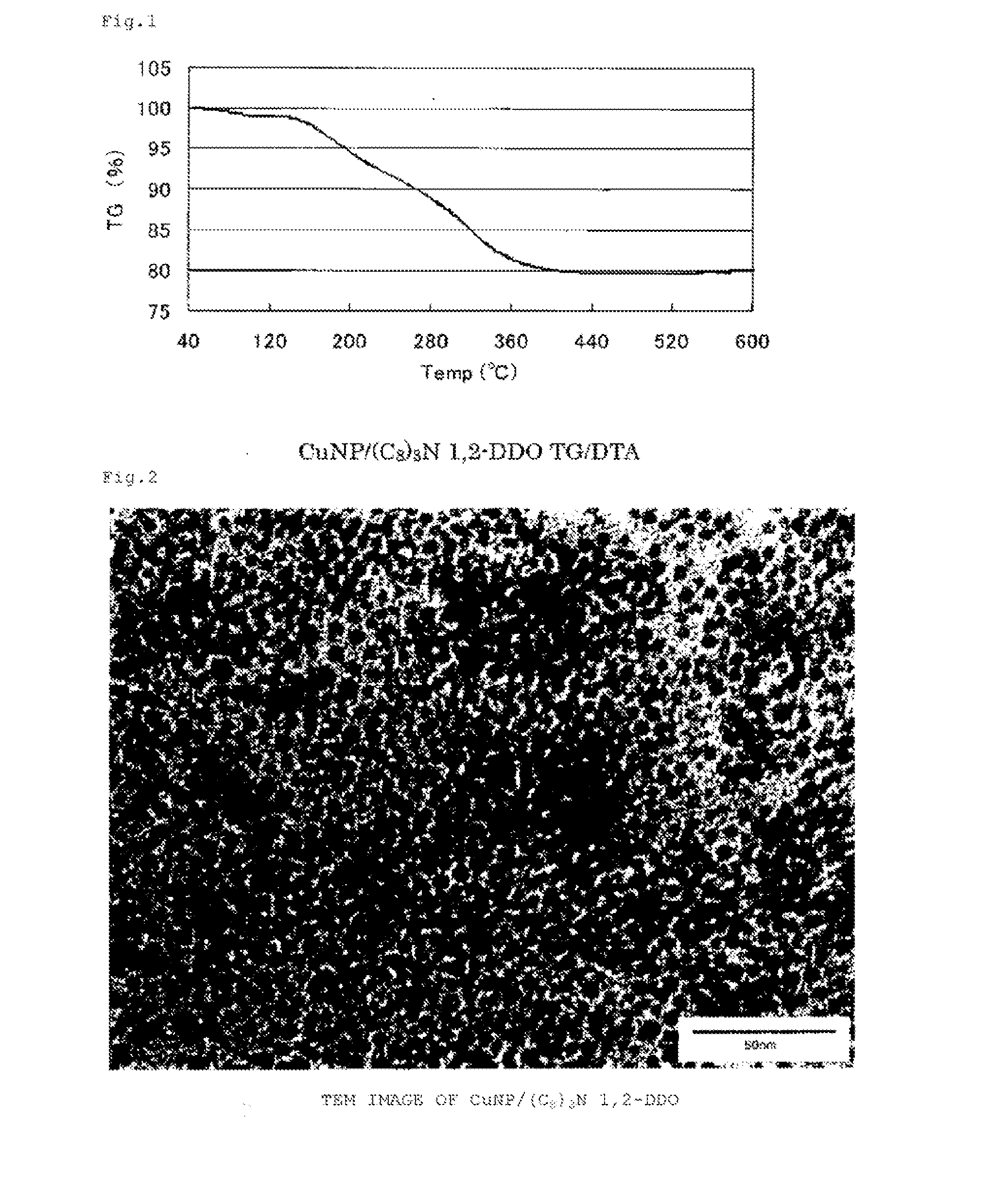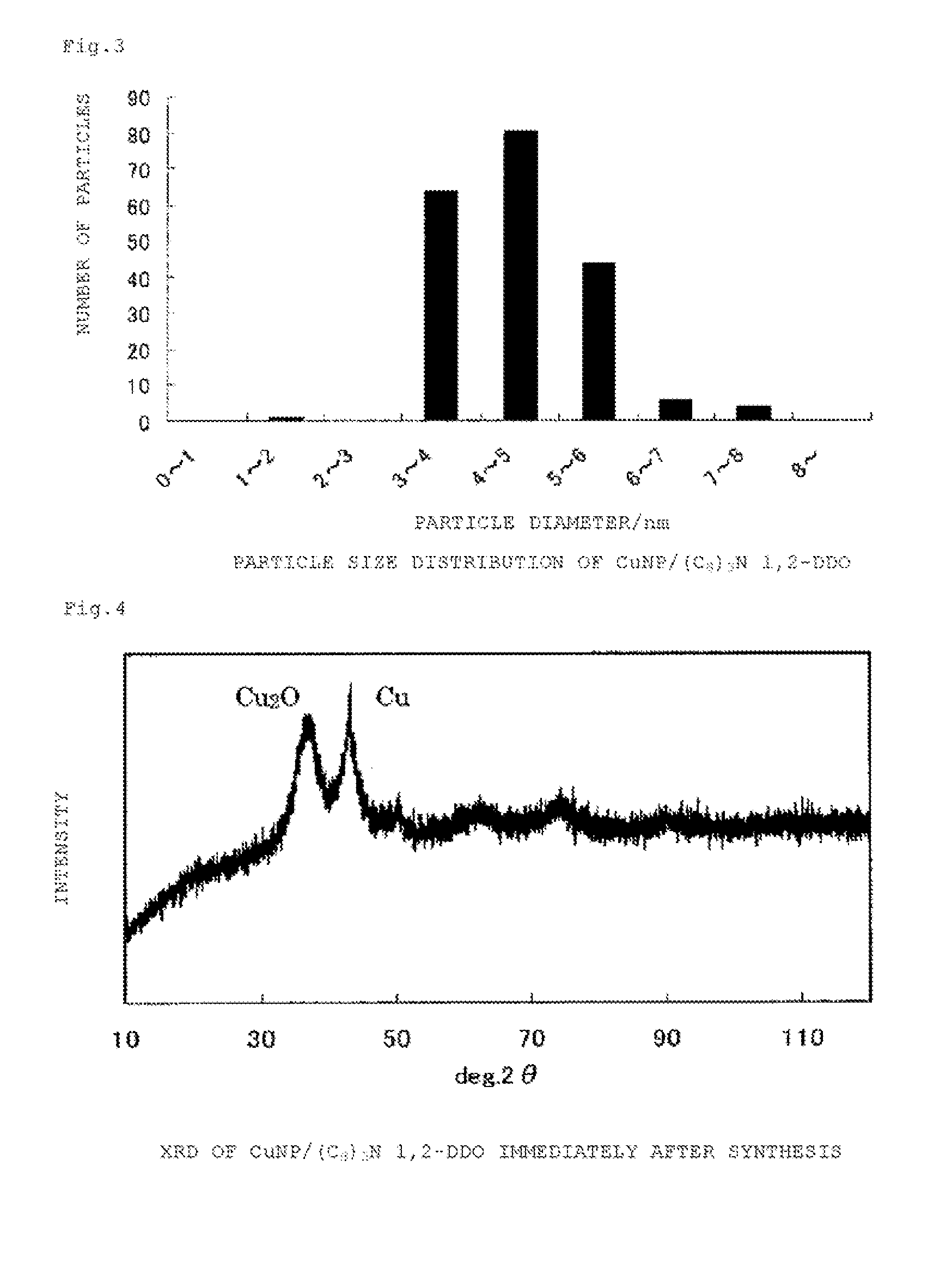Copper-containing nanoparticles and manufacturing method therefor
a technology of copper-containing nanoparticles and manufacturing methods, which is applied in the direction of non-metal conductors, conductors, transportation and packaging, etc., can solve the problems of inability to obtain particles hundreds of nanometers or less in size, inability to synthesis quantities, and inability to achieve quantity synthesis methods, etc., to achieve excellent dispersion stability, excellent oxidation resistance, and efficient manufacturing
- Summary
- Abstract
- Description
- Claims
- Application Information
AI Technical Summary
Benefits of technology
Problems solved by technology
Method used
Image
Examples
example 1
Synthesis of CuNP / (C8)3N 1,2-DDO
[0124](C2COO)2Cu (1.75 g, 5.0 mmol) was added to 1,2-DOC (2.02 g, 10 mmol) and (C8)3N (3.57 g, 10 mmol), and the mixture was maintained for 16 hours at 160° C. in a nitrogen atmosphere and then cooled to room temperature. This was washed with acetone (20 ml), filtered with a Kiriyama funnel, and dried under reduced pressure to obtain a blackish-brown powder (yield 0.38 g / 95%, metal content 80%, mean particle diameter 4.5±0.93 nm). FIG. 1 shows the results for thermogravimetric (TG) change according to TG / DTA measurement, FIG. 2 shows a TEM image, FIG. 3 shows the particle size distribution, and FIG. 4 shows the results of X-ray diffraction analysis (XRD) of the resulting powder.
example 2
Synthesis of CuNP / 1,2-DDO
[0125](C2COO)2Cu (1.75 g, 5.0 mmol) was added to 1,2-DDO (2.02 g, 10 mmol), and the mixture was maintained for 16 hours at 160° C. in a nitrogen atmosphere and then cooled to room temperature. This was washed with acetone (20 ml), filtered with a Kiriyama funnel, and dried under reduced pressure to obtain a blackish-brown powder (yield 0.24 g / 76%, metal content 99.8%, mean particle diameter 24.2±13.9 nm). FIG. 5 shows a TEM image, FIG. 6 shows the particle size distribution, and FIG. 7 shows the results of X-ray diffraction analysis (XRD) of the resulting powder.
example 3
Synthesis of CuNP / (iPr)2NEt 1,2-DDO
[0126]A powder (yield 0.31 g / 79%, metal content 81%, mean particle diameter 5.1±0.90 nm) was obtained by a reaction similar to that of Example 1 except that (iPr)2NEt was substituted for the amine (C8)3N used in Example 1. FIG. 8 shows the results for thermogravimetric (TG) change according to TG / TA measurement, FIG. 9 shows a TEM image, FIG. 10 shows the particle size distribution, and FIG. 11 shows the results of X-ray diffraction analysis (XRD) of the resulting powder.
PUM
| Property | Measurement | Unit |
|---|---|---|
| Temperature | aaaaa | aaaaa |
| Fraction | aaaaa | aaaaa |
| Time | aaaaa | aaaaa |
Abstract
Description
Claims
Application Information
 Login to View More
Login to View More - R&D
- Intellectual Property
- Life Sciences
- Materials
- Tech Scout
- Unparalleled Data Quality
- Higher Quality Content
- 60% Fewer Hallucinations
Browse by: Latest US Patents, China's latest patents, Technical Efficacy Thesaurus, Application Domain, Technology Topic, Popular Technical Reports.
© 2025 PatSnap. All rights reserved.Legal|Privacy policy|Modern Slavery Act Transparency Statement|Sitemap|About US| Contact US: help@patsnap.com



